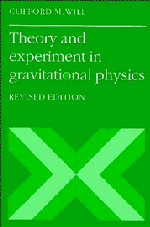Book contents
- Frontmatter
- Contents
- Preface to Revised Edition
- Preface to First Edition
- 1 Introduction
- 2 The Einstein Equivalence Principle and the Foundations of Gravitation Theory
- 3 Gravitation as a Geometric Phenomenon
- 4 The Parametrized Post-Newtonian Formalism
- 5 Post-Newtonian Limits of Alternative Metric Theories of Gravity
- 6 Equations of Motion in the PPN Formalism
- 7 The Classical Tests
- 8 Tests of the Strong Equivalence Principle
- 9 Other Tests of Post-Newtonian Gravity
- 10 Gravitational Radiation as a Tool for Testing Relativistic Gravity
- 11 Structure and Motion of Compact Objects in Alternative Theories of Gravity
- 12 The Binary Pulsar
- 13 Cosmological Tests
- 14 An Update
- References
- References to Chapter 14
- Index
4 - The Parametrized Post-Newtonian Formalism
Published online by Cambridge University Press: 04 April 2011
- Frontmatter
- Contents
- Preface to Revised Edition
- Preface to First Edition
- 1 Introduction
- 2 The Einstein Equivalence Principle and the Foundations of Gravitation Theory
- 3 Gravitation as a Geometric Phenomenon
- 4 The Parametrized Post-Newtonian Formalism
- 5 Post-Newtonian Limits of Alternative Metric Theories of Gravity
- 6 Equations of Motion in the PPN Formalism
- 7 The Classical Tests
- 8 Tests of the Strong Equivalence Principle
- 9 Other Tests of Post-Newtonian Gravity
- 10 Gravitational Radiation as a Tool for Testing Relativistic Gravity
- 11 Structure and Motion of Compact Objects in Alternative Theories of Gravity
- 12 The Binary Pulsar
- 13 Cosmological Tests
- 14 An Update
- References
- References to Chapter 14
- Index
Summary
We have seen that, despite the possible existence of long-range gravitational fields in addition to the metric in various metric theories of gravity, the postulates of metric theories demand that matter and nongravitational fields be completely oblivious to them. The only gravitational field that enters the equations of motion is the metric g. The role of the other fields that a theory may contain can only be that of helping to generate the spacetime curvature associated with the metric. Matter may create these fields, and they, plus the matter, may generate the metric, but they cannot interact directly with the matter. Matter responds only to the metric.
Consequently, the metric and the equations of motion for matter become the primary theoretical entities, and all that distinguishes one metric theory from another is the particular way in which matter and possibly other gravitational fields generate the metric.
The comparison of metric theories of gravity with each other and with experiment becomes particularly simple when one takes the slow-motion, weak-field limit. This approximation, known as the post-Newtonian limit, is sufficiently accurate to encompass all solar system tests that can be performed in the foreseeable future. The post-Newtonian limit is not adequate, however, to discuss gravitational radiation, where the slowmotion assumption no longer holds, or systems with compact objects such as the binary pulsar, where the weak-field assumption is not valid, or cosmology, where completely different assumptions must be made. These issues will be dealt with in later chapters.
- Type
- Chapter
- Information
- Theory and Experiment in Gravitational Physics , pp. 86 - 115Publisher: Cambridge University PressPrint publication year: 1993

